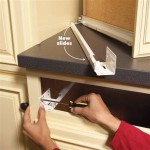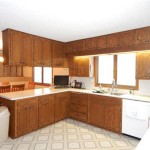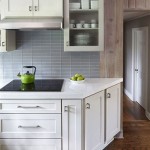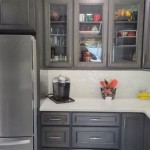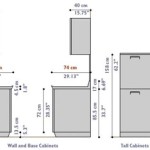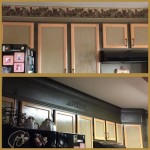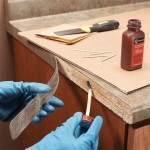Concrete Kitchen Cabinets in Malaysia: An Overview
Concrete kitchen cabinets are gaining traction in Malaysia as homeowners and designers alike seek durable, aesthetically unique, and modern solutions for their culinary spaces. This construction material, traditionally associated with industrial settings, offers a surprising versatility and can be incorporated into a wide range of kitchen designs, from minimalist and contemporary to rustic and even slightly more traditional styles. This article will explore the characteristics, benefits, design considerations, and practical aspects of using concrete for kitchen cabinets in the Malaysian context.
The shift towards concrete in interior design, particularly in kitchen spaces, reflects a broader trend towards embracing raw materials and celebrating the inherent qualities of construction materials. Concrete, with its natural variations in color and texture, offers a distinctive look that is difficult to replicate with other materials. Its robustness also appeals to homeowners seeking long-lasting and low-maintenance solutions. Furthermore, the ability to customize concrete in terms of shape, size, and finish allows for a high degree of personalization in kitchen design, making it a compelling option for those seeking a bespoke culinary environment.
In Malaysia, the suitability of concrete as a building material is further enhanced by its thermal properties. While not a primary factor in cabinet selection, the inherent coolness of concrete can contribute to a more comfortable kitchen environment, particularly in warmer climates. However, the design and installation process requires careful consideration of factors such as weight, sealing, and moisture control to ensure optimal performance and longevity.
Durability and Longevity: The Foundation of Concrete Cabinets
One of the primary advantages of concrete kitchen cabinets is their exceptional durability. Concrete, when properly mixed and cured, is resistant to scratches, dents, and impacts that can easily damage cabinets made from wood or laminate. This inherent strength makes concrete cabinets an ideal choice for busy kitchens that experience heavy use. The material is also less susceptible to warping or swelling due to moisture exposure, a significant concern in tropical climates like Malaysia.
Unlike wood, concrete is not susceptible to rot or insect infestation. This resistance contributes to the long-term structural integrity of the cabinets and reduces the need for frequent repairs or replacements. Furthermore, concrete is a non-combustible material, offering a higher degree of fire resistance compared to wood-based alternatives. This fire-resistant property can provide an added layer of safety in the event of a kitchen fire.
The longevity of concrete cabinets also translates to a lower life-cycle cost. While the initial investment may be higher compared to traditional options, the reduced need for maintenance and repairs, combined with the extended lifespan of the cabinets, can result in significant cost savings over time. Homeowners seeking a long-term investment in their kitchen will find concrete to be a compelling choice.
However, the durability of concrete cabinets is contingent upon proper sealing and maintenance. Unsealed concrete is porous and can absorb stains and moisture. Regular cleaning with appropriate cleaning agents and periodic resealing is necessary to preserve the appearance and integrity of the cabinets.
Design Flexibility and Aesthetic Versatility
Beyond its durability, concrete offers a significant degree of design flexibility. Concrete can be cast into virtually any shape or size, allowing for custom cabinet configurations that maximize space utilization and cater to specific storage needs. This adaptability is particularly useful in kitchens with unusual layouts or limited space.
The aesthetic possibilities of concrete are equally impressive. Concrete can be stained, dyed, or polished to achieve a wide range of colors and finishes. Integral color pigments can be added to the concrete mix to create custom hues that complement the overall kitchen design. Alternatively, the concrete can be left in its natural grey tone for a more industrial or minimalist look. The surface can be polished to a high gloss for a modern and sleek appearance, or it can be left with a rougher texture for a more rustic and natural feel.
Concrete can also be combined with other materials, such as wood, metal, or glass, to create visually interesting and functional kitchen designs. For example, concrete cabinet doors can be paired with wooden frames for a warm and inviting aesthetic, or concrete countertops can be combined with metal cabinet hardware for an industrial-chic look. The versatility of concrete allows designers to create unique and personalized kitchen spaces that reflect the homeowner's individual style.
In Malaysia, the incorporation of local design elements can further enhance the aesthetic appeal of concrete kitchen cabinets. Traditional motifs or patterns can be incorporated into the concrete through stenciling or etching, adding a touch of cultural identity to the modern material. The use of locally sourced aggregates, such as granite or river stones, can also add a unique texture and character to the concrete surface.
Practical Considerations for Concrete Kitchen Cabinets in Malaysia
While concrete offers numerous advantages as a material for kitchen cabinets, there are several practical considerations that homeowners in Malaysia should be aware of before making the decision to install them. These include weight, installation requirements, sealing and maintenance, and cost.
The weight of concrete is a significant factor to consider. Concrete is a heavy material, and concrete cabinets can be significantly heavier than cabinets made from wood or laminate. This weight can pose challenges during installation and may require additional structural support in the kitchen to ensure that the cabinets are adequately supported. It is essential to consult with a structural engineer or experienced contractor to assess the structural integrity of the kitchen floor and walls before installing concrete cabinets. The weight also affects the ease of moving or reconfiguring the cabinets in the future.
The installation of concrete cabinets requires specialized skills and equipment. Due to the weight and complexity of the installation, it is not a DIY project. It is crucial to hire an experienced contractor who is familiar with working with concrete and has the necessary tools and equipment to handle the installation. The contractor should also be knowledgeable about local building codes and regulations to ensure that the installation is compliant.
As previously mentioned, sealing and maintenance are crucial for preserving the appearance and integrity of concrete cabinets. Concrete is porous and can absorb stains and moisture if not properly sealed. A high-quality sealer should be applied to the concrete surface to protect it from stains and moisture. The sealer should be reapplied periodically, depending on the type of sealer used and the level of use that the cabinets receive. Regular cleaning with a pH-neutral cleaner is also recommended to prevent the buildup of dirt and grime.
While the long-term cost benefits of concrete cabinets can be significant, the initial investment is typically higher than that of traditional cabinet materials. The cost of concrete cabinets will vary depending on the size and complexity of the project, the type of concrete used, the finish selected, and the labor costs involved in installation. It is essential to obtain multiple quotes from different contractors and to carefully consider all of the costs involved before making a decision. The higher initial cost should be weighed against the long-term durability and low maintenance requirements of concrete cabinets.
Furthermore, homeowners in Malaysia should consider the local climate when selecting concrete for their kitchen cabinets. The high humidity levels in Malaysia can exacerbate moisture-related issues with concrete if it is not properly sealed. It is crucial to choose a sealer that is specifically designed for use in humid environments and to ensure that the concrete is thoroughly sealed before it is exposed to moisture. Proper ventilation in the kitchen can also help to mitigate the effects of humidity on the concrete cabinets.
Finally, it is important to source concrete materials from reputable suppliers who adhere to quality control standards. The quality of the concrete mix will directly impact the durability and appearance of the cabinets. Homeowners should request information about the composition of the concrete mix and the curing process used by the supplier to ensure that they are receiving a high-quality product. Working with a contractor who has established relationships with reliable concrete suppliers is also recommended.

Concrete Kitchen Countertops With Melamine Cabinets

Concrete Kitchen Countertops With Melamine Cabinets

Concrete Kitchen Countertops With Melamine Cabinets

Concrete Table Top Kitchen Cabinet Malaysia Reference Renovation Design Homebagus Home And Deco Expo

The Best Concrete Table Top Contractor In Semenyih Now Selangor Kuala Lumpur Kl Malaysia Services Hin Construction Sdn Bhd

The Best Concrete Table Top Contractor In Semenyih Now Selangor Kuala Lumpur Kl Malaysia Services Hin Construction Sdn Bhd

Concrete Table Top Kitchen Cabinet Malaysia Reference Renovation Design Homebagus Home And Deco Expo

Melamine Kitchencabinet Wetkitchen Concretetop Greyish Woodtexture Horizontal Lshape Goldencarpentry Malaysia Kitchen Cabinets Wood Texture

Concrete Kitchen Countertops With Melamine Cabinets

Concrete Kitchen Countertops With Melamine Cabinets
Related Posts

